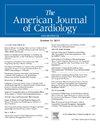Transcatheter Aortic Valve Replacement With a Fully Retrievable Self-Expanding Dry-Tissue Valve: First-in-Man Study
IF 2.3
3区 医学
Q2 CARDIAC & CARDIOVASCULAR SYSTEMS
引用次数: 0
Abstract
Contemporary self-expanding transcatheter aortic valve replacement (TAVR) devices are retrievable and repositionable at partial release, however, valve migration may occur during final release. The Venus-PowerX Valve is a novel self-expanding dry-tissue TAVR device which is retrievable at 100% full deployment. This first-in-man study sought to evaluate the feasibility and safety of the new TAVR device. The clinical outcomes and adverse events were assessed and reported according to the Valve Academic Research Consortium-3 criteria. A total of 25 patients with severe aortic stenosis (75.3 ± 5.3 years, 48.0% male, 52.0% bicuspid aortic valve) were enrolled. Acute technical success was achieved in 25 (100%) patients. Valve recapture at 100% full deployment was attempted in 2 patients due to suboptimal position or inappropriate valve size, and was successful in both. No patient required a second valve. At 30 days, device success was achieved in 88.0%. The reasons for unachieved device success included residual gradient (4.0%), moderate paravalvular leak (PVL, 4.0%) and VARC type 2 bleeding (4.0%). New permanent pacemaker was required in 5 (20.0%) patients. At 1-year follow-up, overall survival rate was 96.0%, there was no stroke, myocardial infarction, or cardiovascular rehospitalization. Mean aortic valve gradient improved significantly from 56.0 ± 17.9 mmHg to 11.6 ± 6.0 mmHg, and effective orifice area improved from 0.6 ± 0.2 cm2 to 1.8 ± 0.4 cm2; 79.1% had none or trivial PVL. In conclusion, the novel fully retrievable Venus-PowerX Valve could enable highly predictable TAVR device positioning and produce satisfactory hemodynamic and clinical outcomes in both bicuspid and tricuspid aortic valve stenosis.
经导管主动脉瓣置换术采用完全可回收的自膨胀干组织瓣:首次在男性研究。
当代自膨胀经导管主动脉瓣置换术(TAVR)装置在部分释放时是可回收和可重新定位的,然而,在最终释放时可能会发生瓣膜迁移。Venus-PowerX瓣膜是一种新型的自膨胀干组织TAVR装置,在100%全展开时可回收。这项首次人体研究旨在评估新型TAVR装置的可行性和安全性。临床结果和不良事件根据瓣膜学术研究联盟-3标准进行评估和报告。共纳入25例重度主动脉瓣狭窄患者(75.3±5.3岁,男性48.0%,双尖瓣52.0%)。25例(100%)患者获得了急性技术成功。2例患者由于瓣膜位置不佳或瓣膜尺寸不合适,在100%完全展开时尝试重新获得瓣膜,并均获得成功。没有病人需要第二个瓣膜。30天时,装置成功率为88.0%。器械未成功的原因包括残余梯度(4.0%)、中度瓣旁漏(PVL, 4.0%)和VARC 2型出血(4.0%)。5例(20.0%)患者需要新的永久性起搏器。随访1年,总生存率为96.0%,无卒中、心肌梗死或心血管再住院。平均主动脉瓣梯度由56.0±17.9 mmHg改善至11.6±6.0 mmHg,有效开口面积由0.6±0.2 cm2改善至1.8±0.4 cm2;79.1%没有或有轻微PVL。总之,新型的完全可回收的Venus-PowerX瓣膜可以高度预测TAVR装置的定位,并在二尖瓣和三尖瓣主动脉瓣狭窄中产生令人满意的血流动力学和临床结果。
本文章由计算机程序翻译,如有差异,请以英文原文为准。
求助全文
约1分钟内获得全文
求助全文
来源期刊

American Journal of Cardiology
医学-心血管系统
CiteScore
4.00
自引率
3.60%
发文量
698
审稿时长
33 days
期刊介绍:
Published 24 times a year, The American Journal of Cardiology® is an independent journal designed for cardiovascular disease specialists and internists with a subspecialty in cardiology throughout the world. AJC is an independent, scientific, peer-reviewed journal of original articles that focus on the practical, clinical approach to the diagnosis and treatment of cardiovascular disease. AJC has one of the fastest acceptance to publication times in Cardiology. Features report on systemic hypertension, methodology, drugs, pacing, arrhythmia, preventive cardiology, congestive heart failure, valvular heart disease, congenital heart disease, and cardiomyopathy. Also included are editorials, readers'' comments, and symposia.
 求助内容:
求助内容: 应助结果提醒方式:
应助结果提醒方式:


